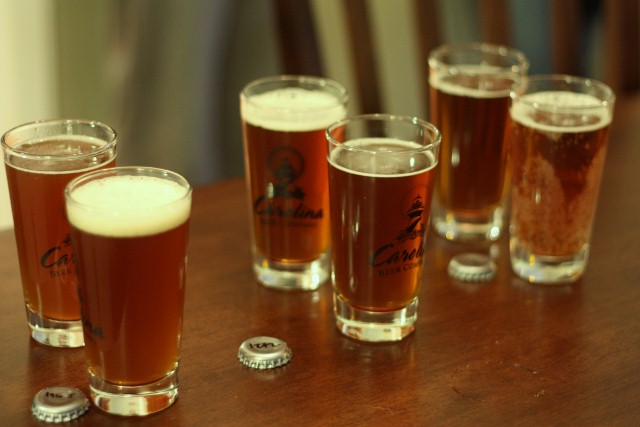I tasted these for the first time during the Superbowl, but I've been a turd about getting on here and finally posting the results.
From L-R, 1968, 1272, 1056 (not that the picture is giving you too much info here)
Very interesting experiment overall, and I got the data that I wanted, but there were a few problems.
1056 - FG ended at 1.015. Definitely the cleanest of the three. Very mild ale-fruitiness and the hops are present without being overwhelming. Hoppiness is well blended, and the beer has an overall great balance. Very fresh and bright tasting.
Unfortunately, this beer has the biggest problem of the three - I'm getting a weird phenolic flavor or maybe some yeast-bite, as if I had used some sort of Belgian yeast. It's not so overpowering that I can't see through it to what the beer is supposed to be, but it's definitely noticeable. I don't understand what this could be from, because these three beers were fermented under identical conditions, around 68*, and because of the low flocculation of this yeast, I actually gave it more time than the other beers to settle out. THEN I added gelatin in the keg a week before bottling just to help with de-yeasting. I've had really bad experiences with California Ale yeast, specifically with yeast bite flavors, and I attribute it to its low flocculation.
The craziest part is that this phenolic flavor wasn't present until I did the official tasting. Nothing from the hydrometer samples, or during carbonation in the keg. Everything indicated it was going to be fine. And this flavor is present in all the bottles I've tried, not just a stray one here and there. Frankly, it makes me want to swear off Cal-ale forever, but we'll see.
1272 - FG was 1.016, and it's interesting how the one extra gravity point seems to manifest in a noticeable amount of extra body and sweetness over the 1056 batch. In general, this beer seems to have taken each individual thing about the 1056 and intensified it. Slightly more maltiness, a good bit more hoppiness, and a decidedly toasty quality to the beer. It's also a bit less "clean," in the sense that it has some funky "ale-ness" going on. Nothing off-putting at all, but it's just got a lot of fruitiness and maybe bready flavors that just aren't found in 1056.
I'm really happy with this beer. The hops especially are quite pronounced, so I'd recommend this to other hop-heads out there for your next APA/IPA. Lemony and crisp hops. If I were to make this again, I'd cut back on the Munich malt (or maybe leave it out entirely) because the toasty quality is one of the dominant flavors. Its flavor and intensity is akin to a well-toasted piece of whole wheat bread - very hearty and rich.
1968 - Holy crap this is malty. FG 1.018. Huge body, and much sweeter than the other two beers. Still, the sweetness is not unpleasant or syrupy. This beer has a really interesting balance. Both hops and malt work well together, but in an entirely different way than in the 1056. The malt character is bready or even doughy. Its thickness is chewable and satisfying on your tongue. Hops are still noticeable, but slightly undercut by the malt. Even though you know you're drinking something made with American citrusy hops, they have a more floral character in this beer that doesn't smack you with hoppiness but instead is a ever-present and supporting background player.
I was probably a little too eager to get on with this experiment and ended up kegging this a little early (8 days in)- my loss, because it has a touch of diacetyl. Not overpowering, but a little slick/greasy on the tongue. No butter, though, so it's not out of control.
Overall, the 1968 is probably my favorite, but there's one thing I would change if I brewed it again - more hops. Probably another 14g in both the flavor and aroma, and I would aim for another 5-8 IBUs. Again, this isn't so much because I think "this beer is too sweet," but because it needs more bitter/sweet balance to be accepted as an APA. Also, I'd give it longer in the primary.
And it'll probably anger some people for me to say I'm probably giving Cal-ale the boot. Not permanently, but I'll usually reach for a different yeast in its place. While I realize I must have made some mistake here myself, this still is another tick on this yeast's report card. I'm just tired of dealing with problems.
Besides my complaints about 1056, I have so many more positives about the other yeasts. In general, I like my beers to be less dry than most people prefer, and I like the extra maltiness you can get from these two. If that means that bitterness and flavor/aroma are reduced, that's fine by me - I can always add more hops!
I encourage other people to do a similar experiment, I had a great time doing this.


